September – Alopecia Awareness Month: no better time to stop and consider:
- Alopecia and its various forms.
- Interesting facts associated with alopecia.
Alopecia and its Various Forms
Alopecia simply means hair loss. Alopecia is a medical condition. As a medical condition, alopecia associates with the medical field of dermatology and autoimmune disorders. Check out the major medical/dermatological associations and you’ll quickly see there is agreement that alopecia occurs when a man or a woman’s immune system attacks their hair follicles, resulting in hair falling out. Alopecia affects adults and children. Dermatologists typically diagnose alopecia. Dermatologists are medical doctors who are trained to make such diagnoses using a variety of techniques, including microscopic analysis of the hair, skin biopsies, and blood tests. Alopecia is not contagious. The world’s leading medical associations indicate there is no known cure to date, although if you look hard enough you’ll stumble upon “magic” cures being marketed by opportunists and marketing spin doctors.
There are various forms of alopecia, including:
Alopecia Areata
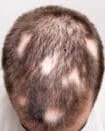 Do you see a patchy spot developing on your cranium where hair used to be? Experiencing patchy hair loss? Are the patches oval or round? You may have alopecia areata. Maybe you notice a difference with your nails too. Alopecia areata is known to associate with fingernail and/or toenail abnormalities such as the appearance of tiny dot depressions in the nail plate, thinning of the nail plate, a smooth texture becoming rough, a dullness, and even the shedding of the nail plate. Fortunately, you’re not experiencing physical pain. Lots of men and women who experience the signs of alopecia areata experience worry, though. For obvious reasons: your physical appearance is under attack, and your psychological state may be negatively impacted. Is yours? Are you thinking you need to do something to counterattack your alopecia areata?
Do you see a patchy spot developing on your cranium where hair used to be? Experiencing patchy hair loss? Are the patches oval or round? You may have alopecia areata. Maybe you notice a difference with your nails too. Alopecia areata is known to associate with fingernail and/or toenail abnormalities such as the appearance of tiny dot depressions in the nail plate, thinning of the nail plate, a smooth texture becoming rough, a dullness, and even the shedding of the nail plate. Fortunately, you’re not experiencing physical pain. Lots of men and women who experience the signs of alopecia areata experience worry, though. For obvious reasons: your physical appearance is under attack, and your psychological state may be negatively impacted. Is yours? Are you thinking you need to do something to counterattack your alopecia areata?
Androgenetic Alopecia
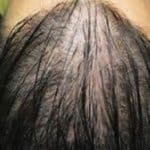
 Androgenetic alopecia associated to women is Female Pattern Baldness and androgenetic alopecia to men is Male Pattern Baldness. Women…are you noticing diffuse thinning of your hair throughout your scalp? Men…are you noticing hair receding at the crown and frontal and temple regions of your scalp? “Yes,” you answer. Is your confidence about your physical appearance shaken? Are you thinking you need to do something to counterattack your androgenetic alopecia?
Androgenetic alopecia associated to women is Female Pattern Baldness and androgenetic alopecia to men is Male Pattern Baldness. Women…are you noticing diffuse thinning of your hair throughout your scalp? Men…are you noticing hair receding at the crown and frontal and temple regions of your scalp? “Yes,” you answer. Is your confidence about your physical appearance shaken? Are you thinking you need to do something to counterattack your androgenetic alopecia?
Alopecia Totalis
The thing about alopecia is that it mark’s a transformation from living with a full head of hair to baldness. The transformation typically occurs as a process, happening over time. When all the hair on a man or a woman’s scalp is gone and the person affected is bald, the individual is said to have alopecia totalis.
Alopecia Universalis
The most advanced form of alopecia areata, alopecia universalis is marked by the total loss of all hair on the body, including eyelashes and eyebrows.
Alopecia Barbae
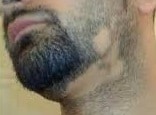 Men experiencing a localized bald spot or patch on the beard area or broader hair loss across the beard area may be dealing with alopecia barbae. Other forms of alopecia you may want to check out include Scarring Alopecia and Traction Alopecia. At the end of the day, everyone wants to look good. If looking good to you means your look with hair, don’t let the alopecia you’re dealing with and your transition to baldness get you down. Take charge and combat it with hair replacement. Your options include non-surgical hair replacement and surgical hair replacement. Natural Choice Hair Replacement is London and southwestern Ontario’s option for non-surgical hair replacement solutions. Non-invasive, pain free. NCHR consults with you. We’re hands-on, proactive, engaging. We work with clients. We order your hair replacement system based on your specifications. We do the fitting mapped to your natural hairline so your look is natural. Just as though you still had your original hair. Cut and styled to perfection, and supported by on-going styling/service support. Your hair loss replaced by your custom hair-replacement solution. Your look with hair. It’s all positive!
Men experiencing a localized bald spot or patch on the beard area or broader hair loss across the beard area may be dealing with alopecia barbae. Other forms of alopecia you may want to check out include Scarring Alopecia and Traction Alopecia. At the end of the day, everyone wants to look good. If looking good to you means your look with hair, don’t let the alopecia you’re dealing with and your transition to baldness get you down. Take charge and combat it with hair replacement. Your options include non-surgical hair replacement and surgical hair replacement. Natural Choice Hair Replacement is London and southwestern Ontario’s option for non-surgical hair replacement solutions. Non-invasive, pain free. NCHR consults with you. We’re hands-on, proactive, engaging. We work with clients. We order your hair replacement system based on your specifications. We do the fitting mapped to your natural hairline so your look is natural. Just as though you still had your original hair. Cut and styled to perfection, and supported by on-going styling/service support. Your hair loss replaced by your custom hair-replacement solution. Your look with hair. It’s all positive!
Central Centrifugal Cicatrical Alopecia (CCCA)
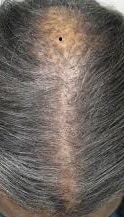 Women experiencing hair thinning at the center of their scalp followed by gradual hair loss spreading outwards may be dealing with CCCA. CCCA belongs to a group of disorders called cicatricial or scarring alopecia that destroy the hair follicle, replace it with scar tissue, and cause permanent hair loss. To date, the cause is unknown, although medical research associates CCCA to an inflammatory process induced by genetic or environmental factors. The inflammation that destroys the hair follicle is below the skin surface and there is usually no “scar” seen on the scalp. Other names that apply include Follicular degeneration syndrome and hot comb alopecia.
Women experiencing hair thinning at the center of their scalp followed by gradual hair loss spreading outwards may be dealing with CCCA. CCCA belongs to a group of disorders called cicatricial or scarring alopecia that destroy the hair follicle, replace it with scar tissue, and cause permanent hair loss. To date, the cause is unknown, although medical research associates CCCA to an inflammatory process induced by genetic or environmental factors. The inflammation that destroys the hair follicle is below the skin surface and there is usually no “scar” seen on the scalp. Other names that apply include Follicular degeneration syndrome and hot comb alopecia.
nbsp;
Frontal Fibrosing Alopecia (FFA)
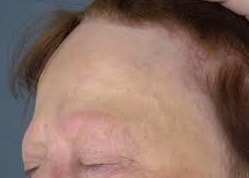 Most commonly affects post-menopausal women. Usually associates with a band of symmetrical hair loss on the front and sides of the scalp near the forehead that worsens over time. Loss of eyebrow hair often associates. To a lesser extent, eyelash loss and hair loss in other areas of the scalp and face occur. The cause is thought to be autoimmune and there is also a suspected hormonal component.
Most commonly affects post-menopausal women. Usually associates with a band of symmetrical hair loss on the front and sides of the scalp near the forehead that worsens over time. Loss of eyebrow hair often associates. To a lesser extent, eyelash loss and hair loss in other areas of the scalp and face occur. The cause is thought to be autoimmune and there is also a suspected hormonal component.
Traction Alopecia
 Traction Alopecia is a hair loss condition resulting from damage to the hair follicle and papilla from continuous tension or pulling over a lengthy period of time. Commonly associated with individuals who put braids on tightly: the “cornrows” effect with pulling, high tension and hair breakage. It can also be a consequence of cosmetic surgery such as facelifts that generate hair tension.
Traction Alopecia is a hair loss condition resulting from damage to the hair follicle and papilla from continuous tension or pulling over a lengthy period of time. Commonly associated with individuals who put braids on tightly: the “cornrows” effect with pulling, high tension and hair breakage. It can also be a consequence of cosmetic surgery such as facelifts that generate hair tension.
Traumatic Alopecia
Typically caused by hairdressing techniques that pull hair (tight braiding or cornrowing), expose hair to extreme heat and twisting (curling iron or hot rollers) or damage the hair with strong chemicals (bleaching, hair coloring, permanent waves).
Interesting Facts Associated with Alopecia:
- There is still no Food and Drug Administration-approved treatment for this disease. But recent studies have helped us understand how alopecia areata occurs, how important interleukin-15 is, and how to target this cytokine as well as others.
- National Alopecia Areata Foundation (NAAF) – Prevalence of hair loss has increased in the 10 to 25 years age group during the most recent decade.
- Approximately 6.8 million people in the U.S. — 147 million people worldwide — are affected by alopecia areata. Lifetime risk is 2.1%.
- The global alopecia market size was valued at USD $2.5 billion in 2018. Continued growth anticipated in the range of > 8% CAGR (compound annual growth rate).
- Alopecia areata and androgenetic alopecia increasingly prevalent. Alopecia areata led the market in 2018, capturing more than 30% of the revenue.
- Rise in incidence of Polycystic Ovary Syndrome (PCOS), cancer, hypothyroidism, hyperthyroidism, acute stress disorder, hypopituitarism, lupus, and other chronic disorders are positively associated with increasing prevalence of alopecia.
- Excessive consumption of alcohol, tobacco, and associated products, and increasing stress levels are considered potent triggers for alopecia.
- Heredity plays a big part in determining if and when you’ll lose your hair. Both your mother’s and father’s genes have a say in whether hair loss is a possibility, although the DNA you inherit from your mom is the strongest influence for hair loss.
- It is estimated that approximately 30 million women and as many as 50 million men experience hair loss as a direct result of their genetic make-up.
How Do You Feel About Your Alopecia Hair Loss and How Do You Want to Look?
At the end of the day, everyone wants to feel good about the way they look. If looking good to you means your look with hair, don’t let the alopecia you’re dealing with and your transition to baldness get you down. Take charge and combat it with hair replacement. Your options include non-surgical hair replacement and surgical hair replacement.
Natural Choice Hair Replacement is London and southwestern Ontario’s option for non-surgical hair replacement solutions. Non-invasive, pain free. NCHR consults with you. We’re hands-on, proactive, engaging. We work with clients. We order your hair replacement system based on your specifications. We do the fitting mapped to your natural hairline so your look is natural: it’s just as though you still had your original hair cut and styled to perfection and supported by on-going styling/service support. Your hair loss replaced by your custom hair-replacement solution. Your look with hair. It’s all positive!
Best,
Casey.
Note other sources to reference about alopecia:
- https://www.headcovers.com/resources/alopecia/types-of-alopecia
- https://www.naaf.org/alopecia-areata/faqs
- https://www.wiseguyreports.com/reports/3902926-global-hair-loss-medication-market-2019-2026
- https://www.creditdonkey.com/hair-loss-statistics.html
- https://www.grandviewresearch.com/press-release/global-alopecia-market
- https://https://www.health.harvard.edu/a_to_z/hair-loss-a-to-z
- https://www.naaf.org/programs/september-is-alopecia-areata-awareness-month
- https://www.mdedge.com/internalmedicine/article/189346/hair-nails/expert-qa-whats-new-alopecia-areata-research-and
- https://www.aad.org/public/diseases/hair-and-scalp-problems/alopecia-areata#treatment
- https://www.aad.org/public/diseases/hair-and-scalp-problems/alopecia-areata#overview
- https://www.niams.nih.gov/health_info/alopecia_areata/alopecia_areata_ff.asp#b
- https://www.naaf.org/alopecia-areata/faqs
- https://www.americanhairloss.org/men_hair_loss/introduction.asp
- https://nahrs.org/PatientInformation(FAQs)/AlopeciaAreata(FAQ).aspx
- https://www.alopeciaonline.org.uk/types-of-alopecia.asp
- https://www.alopeciacure.com/typesofalopecia.html
